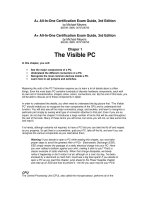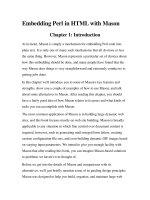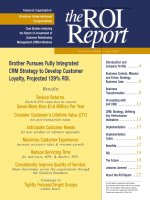Tài liệu The Law ( In plan English) for the small Business pdf
Bạn đang xem bản rút gọn của tài liệu. Xem và tải ngay bản đầy đủ của tài liệu tại đây (1.43 MB, 322 trang )
Doing it right is not.
Leonard D. DuBoff, Attorney at Law
for Small
Business
Organize Your Business • Develop a Business Plan
Finance a New Business • Work with Contracts
Hire Employees • Collect Overdue Accounts
®
THE
(IN PLAIN
ENGLISH)
®
DuBoff
EAN
UPC
S
PHINX
®
P
UBLISHING
AN IMPRINT OF SOURCEBOOKS, INC.
®
NAPERVILLE, ILLINOIS
www.SphinxLegal.com
Business $19.95 U.S.
$29.95 CAN
Every decision you make today directly impacts your future success. Careful
planning is crucial for identifying your goals and creating a path to achievement.
Understanding the many legal obligations as well as legal protections available
to you is key.
The Law (In Plain English)
®
for Small Business is your one-stop guide for making
the right decision every time. It covers the topics that concern you the most and
provides clear and accurate explanations of the laws affecting your small
business. All the basic tools needed to begin operations are included such as—
Starting a small business is easy.
Doing it right is not.
• Succession Planning
• eBusiness Considerations
Small Business
for Small Business
LAW
LAW
The Law (In Plain English)
®
for Small Business helps you keep an eye
toward the future by examining the unique issues of—
No matter what stage your business is at, it is never too late to get on track. So,
whether you are thinking about opening a small business, wanting to make sure
that you do it right, or ready to expand to the next level—
The Law (In Plain English)
®
for Small Business has everything you need!
• Incorporating
• Licenses
• Advertising
• Trademarks
• Taxes
• Insurance
• Franchising
• Multilevel Marketing
THE LAW
(IN PLAIN ENGLISH)
®
for SMALL
BUSINESS
Leonard D. DuBoff
Attorney at Law
SPHINX
®
PUBLISHING
AN IMPRINT OF SOURCEBOOKS, INC.
®
NAPERVILLE, ILLINOIS
www.SphinxLegal.com
Printed and bound in the United States of America.
VHO — 10 9 8 7 6 5 4 3 2
Library of Congress Cataloging-in-Publication Data
DuBoff, Leonard D.
The law (in plain English) for small businesses / by Leonard D. DuBoff
p. cm.
Includes index.
ISBN 1-57248-377-6 (alk. paper)
1. Business law United States. 2. Small business United States. I.
Title.
KF390.B84D83 2004
346.73'0652 dc22
2004001921
Copyright © 2004 by Leonard D. DuBoff
Cover and internal design © 2004 by Sourcebooks, Inc.
®
All rights reserved. No part of this book may be reproduced in any form or by any electronic or mechan-
ical means including information storage and retrieval systems—except in the case of brief quotations
embodied in critical articles or reviews—without permission in writing from its publisher, Sourcebooks,
Inc.
®
First Edition, 2004
Second Printing: July, 2004
Published by: Sphinx
®
Publishing, An Imprint of Sourcebooks, Inc.
®
Naperville Office
P. O. Box 4410
Naperville, Illinois 60567-4410
630-961-3900
Fax: 630-961-2168
www.sourcebooks.com
www.SphinxLegal.com
This publication is designed to provide accurate and authoritative information in regard to the subject
matter covered. It is sold with the understanding that the publisher is not engaged in rendering legal,
accounting, or other professional service. If legal advice or other expert assistance is required, the serv-
ices of a competent professional person should be sought.
From a Declaration of Principles Jointly Adopted by a Committee of the
American Bar Association and a Committee of Publishers and Associations
This product is not a substitute for legal advice.
Disclaimer required by Texas statutes.
Dedication
To my wife, Mary Ann Crawford DuBoff,
for all you have done and for all we have together,
and to my mother, Millicent DuBoff,
for giving me the tools necessary to create this work
and the drive to actually do it.
Finally, to my grandson, Brian Michael Haak,
with hopes that he will carry on the tradition.
There are a host of individuals who have aided me in preparing The Law (in Plain
English)
®
for Small Business for publication. It is impossible to identify all of them
within these pages, but some deserve special recognition. I would like to thank the
following friends, colleagues, former students, and associates for their valuable assis-
tance. In particular, I would like to thank Christy O. King, principal in the law firm
of DuBoff Law Group, LLC, for her aid in spearheading much of the revision work
that contributed to this book. Without her attention to detail, this revision would
not have been possible.
Jed Macy of The Macy Company was extraordinarily helpful in providing up-to-
date and accurate information about pensions and profit-sharing plans. I am also
indebted to John Stevko, CPA, speaker for and CEO of the tax and accounting edu-
cation company Gear Up, Inc., for his aid with the numerous changes in tax law. I
would also like to thank Mary L. Culshaw, CPA/PFS, CFP, of the accounting firm
of Napier and Company, for her help in revising the tax chapter of this book. John
and Mary are extremely knowledgeable with respect to small business tax issues.
Dan Clark, Vice President of Banner Bank, was kind enough to review Chapter 4,
“Borrowing from Banks”, and provide me with practical, useful recommendations.
His years of banking experience provided invaluable insight into the process of deal-
ing with banks.
My colleague and former student, Emil Berg, was extremely helpful in providing
recommendations with respect to the material contained in the chapter on insur-
ance law. I would also like to thank John Smith-Hill of the law firm of Smith-Hill
and Bedell for his help in reviewing the patent chapter. John’s knowledge of patent
law is extraordinary, and his help in understanding some of the newer, more com-
plex developments has been important to the quality of this book.
A special thanks to my brother, Michael H. DuBoff, of the law firm of Davidoff &
Malito, for his astute comments and recommendations.
I would also like to thank everyone, and I mean everyone, at Sphinx Publishing for
their cheerful service with this book. In particular, I would like to recognize the spe-
cial help of the division manager, Dianne Wheeler and my editor, Michael Bowen.
I am also indebted to Lynn Della for the countless days she spent assisting me in
reworking the earlier version and compiling the myriad changes that have occurred
in the law. Lynn’s knowledge of law and business and their real-world application
have proved to be a valuable resource. I could not have revised this book without
her help. My secretary, Peggy Reckow, deserves special recognition for her extra
effort in converting my numerous interlinings and cryptic notes into a readable vol-
ume. Her special talent in working with the foibles of the computer system and
transmitting the manuscript to the editors has been extremely beneficial.
My daughters, Colleen and Sabrina, were a tremendous aid in proofing this work
and verifying much of the material that appears in this text. In addition, my son,
Robert, was extremely helpful in educating me on the intricacies of the World Wide
Web and new computer technology. My grandson, Brian, has provided a special
kind of assistance and understanding. There are many days when I would have pre-
ferred to play with him rather than remain closeted with this revision, yet, he
encouraged me to complete this work before enjoying our time together.
Finally, I would like to recognize the aid of my partner in law and in life, Mary Ann
Crawford DuBoff, for all of her work on this text. Words are inadequate to express
the appreciation I feel for all she has contributed to this and all of my projects.
Preface . . . . . . . . . . . . . . . . . . . . . . . . . . . . . . . . . . . . . . . . . . . . . . . xv
Chapter 1: Organizing Your Business. . . . . . . . . . . . . . . . . . . . . . . . . . 1
Sole Proprietorships
Partnerships and Joint Ventures
Limited Partnerships
Corporations
S Corporations
Limited Liability Companies and Limited Liability Partnerships
Hybrids
Chapter 2: Business Organization Checklist. . . . . . . . . . . . . . . . . . . . 17
Accountant
Business Name
Business Structure
CONTENTS
Chapter 3: Developing Your Business Plan. . . . . . . . . . . . . . . . . . . . . 27
Executive Summary
History
Products and Services
The Market
The Competition
Source of Work
Management
Financial Data
The Business Plan Team
Chapter 4: Borrowing from Banks. . . . . . . . . . . . . . . . . . . . . . . . . . . 33
Loan Proposal
Business Outlook
Application
Lender’s Rules and Limitations
Details of the Agreement
Communication when Problems Arise
Venture Capital
Chapter 5: Going Public . . . . . . . . . . . . . . . . . . . . . . . . . . . . . . . . . . 53
Advantages of Going Public
Disadvantages of Going Public
Federal and State Securities Laws
Initial Public Offering
Privatization
Chapter 6: Contracts. . . . . . . . . . . . . . . . . . . . . . . . . . . . . . . . . . . . . 59
Contract Basics
Types of Contracts
Understanding Contract Principles
Proving an Agreement
Essentials to Put in Writng
viii • The Law (In Plain English)
®
for Small Business
No-Cost Written Agreements
Contracting Online
Consumer Protection Laws
Chapter 7: Consignment . . . . . . . . . . . . . . . . . . . . . . . . . . . . . . . . . . 73
Advantages
Disadvantages
Special Laws for Artists
Chapter 8: Collections. . . . . . . . . . . . . . . . . . . . . . . . . . . . . . . . . . . . 81
Point-of-Sale Payments
Consignment
Invoicing
Ways of Encouraging Payment
When Payment Never Comes
Bankruptcies
Chapter 9: Expanding Your Market . . . . . . . . . . . . . . . . . . . . . . . . . . 93
Franchising
Mulitlevel Marketing
Chapter 10: Patents and Trade Secrets . . . . . . . . . . . . . . . . . . . . . . . 103
Patents
Trade Secrets
Chapter 11: Trademarks . . . . . . . . . . . . . . . . . . . . . . . . . . . . . . . . . 109
Definition
Prohibited Trademarks
Protecting a Trademark
Confusingly Similar
Federal Registration
Applications Based on Actual Use
Applications Based on Intent-to-Use
Contents • ix
Constructive Use
Benefits of Registration
Duration
Supplemental Register
Loss of Protection
Infringement
Antidilution
International Protection
State Registration
Using an Attorney
Chapter 12: Copyrights. . . . . . . . . . . . . . . . . . . . . . . . . . . . . . . . . . 125
Copyright Law Foundation
Copyrightable Material
Scope of Protection
Ownership
Works Made for Hire
Derivative Works
Collective Works
Copyright Protection for Utilitarian Objects
Notice Requirement
Application Process
Period of Protection
Infringement
Chapter 13: Advertising. . . . . . . . . . . . . . . . . . . . . . . . . . . . . . . . . . 141
Government Regulation
Comparative Advertising
Publicity and Privacy
Unauthorized Use of Trademark
Trade Dress
x • The Law (In Plain English)
®
for Small Business
Chapter 14: Licensing . . . . . . . . . . . . . . . . . . . . . . . . . . . . . . . . . . . 147
General Consideration
Licensing Hazards
Method of Payment
Acknowledgement of Ownership
Quality Control
Signature
Chapter 15: The Internet. . . . . . . . . . . . . . . . . . . . . . . . . . . . . . . . . 153
Protecting Business Property
Protecting Consumer Information
Domain Names
Internet Advertising
Audits
Copyright Concerns
Server Protection
Spam
Viruses, Worms, and Traps
Security for Online Commerce
Chapter 16: Warranties . . . . . . . . . . . . . . . . . . . . . . . . . . . . . . . . . . 167
Express Warranties
Implied Warranties
Disclaimers
Magnuson-Moss Warranty Act
Using an Attorney
Contents • xi
Chapter 17: Product Liability . . . . . . . . . . . . . . . . . . . . . . . . . . . . . 177
Defective Products
Types of Defects
Federal Laws
Product Liability
Liability Insurance
Chapter 18: Business Insurance . . . . . . . . . . . . . . . . . . . . . . . . . . . . 183
Basics of Insurance Law
Property Covered
When and How to Insure
Chapter 19: People Who Work for You . . . . . . . . . . . . . . . . . . . . . . 193
Independent Contractors
Employees
Employment Contracts
Other Considerations in Hiring
Hazards in the Workplace
Termination of Employment
Chapter 20: Keeping Taxes Low. . . . . . . . . . . . . . . . . . . . . . . . . . . . 203
Income Spreading
Spreading Income among Family Members
Family Corporations and Limited Liability Companies
Qualifying for Business Deductions
Deductions for the Use of a Home in Business
Other Professional Expenses
Travel Expenses
Entertainment Expenses
Conventions
Logbooks
Charitable Deductions
Grants, Prizes, and Awards
Health Insurance
xii • The Law (In Plain English)
®
for Small Business
Chapter 21: Zoning. . . . . . . . . . . . . . . . . . . . . . . . . . . . . . . . . . . . . 225
Local Zoning Restrictions
Federal Regulations
Telecommuting and Web-Based Businesses
Chapter 22: Renting Commercial Space. . . . . . . . . . . . . . . . . . . . . . 231
Premises
Cost
Term
Restrictions
Remodeling
Utilities
Security and Zoning
Written Document
Chapter 23: Pension Plans. . . . . . . . . . . . . . . . . . . . . . . . . . . . . . . . 237
Defined Benefit Plans
Defined Contribution Plans
Designing and Documenting a Plan
Employer-Sponsored Plan
Investments in a Qualified Plan
Chapter 24: Estate Planning . . . . . . . . . . . . . . . . . . . . . . . . . . . . . . 247
The Will
Payment of Testator’s Debts
Disposition of Property not Willed
Advantages to Having a Will
Estate Taxes
Distributing Property Outside the Will
Probate
Contents • xiii
Chapter 25: Finding a Lawyer and an Accountant . . . . . . . . . . . . . . 261
Finding a Lawyer
Finding an Accountant
Glossary . . . . . . . . . . . . . . . . . . . . . . . . . . . . . . . . . . . . . . . . . . . . . 265
Index . . . . . . . . . . . . . . . . . . . . . . . . . . . . . . . . . . . . . . . . . . . . . . . 295
About the Author . . . . . . . . . . . . . . . . . . . . . . . . . . . . . . . . . . . . . . 303
xiv • The Law (In Plain English)
®
for Small Business
When I first began writing The Law (In Plain English)
®
series more than a quar-
ter-century ago, my goal was to educate nonlawyers on the business aspects of
their businesses and professions. At the time, I was a full-time law professor, and
as an educator, I felt that one of my missions was to provide educational tools.
Later, as a full-time lawyer, I realized the importance of this series in educating
my clients so that they could more effectively communicate with me. It became
clear that the more knowledgeable my clients were about the myriad legal issues
they faced in their businesses and professions, the more effectively they could
aid me in helping them. It is for this reason that I continue this series. Today,
there are In Plain English
®
books for writers, high-tech entrepreneurs, healthcare
professionals, craftspeople, gallery operators, photographers, and this volume
for those who are involved with every aspect of small businesses.
The word small, as used in the title, is not intended to limit this text to opera-
tors of ma-and-pa operations. Rather, it is intended to encompass all businesses
that are not publicly traded and listed on national securities exchanges. It is
likely that companies of that size would have in-house counsel trained in the
various subjects discussed in this volume. However, even the principals of such
PREFACE
companies might gain a clearer understanding of the legal issues they deal with
by reading an In Plain English
®
book.
This book is not intended to be a substitute for the advice of a professional.
Instead, it is designed to sensitize you to the issues that may require the aid of a
skilled attorney or other expert. It is my sincere hope that this book will, like its
predecessors in the series, be practical, useful, and readable. One of my goals in
preparing this book is to enable the reader to identify problem areas and seek the
aid of a skilled professional when necessary—or preferably before it becomes
necessary. It is quite common for the owners of small businesses to become
embroiled in legal problems before they are able to appreciate the problem.
The law is quite complex and rapidly evolving. Since the first incarnation of this
text was published in 1987, many changes have occurred. New business forms,
such as limited liability companies and limited liability partnerships, have
emerged. The World Wide Web has become a vehicle for communication and
commerce, and the law has been scrambling to keep pace. In writing this edi-
tion, it was my intention to chronicle the changes and convert them into a clear
and understandable text that will aid the reader in understanding the current
state of business law. It is hoped that by my doing so, business readers will be
able to more effectively communicate with their business associates and legal
advisors when inevitable legal issues arise.
Leonard D. DuBoff
Portland, Oregon, 2004
xvi • The Law (In Plain English)
®
for Small Business
E
veryone in business knows that survival requires careful financial planning,
yet few fully realize the importance of selecting the best form for the busi-
ness. Small businesses have little need for the sophisticated organizational struc-
tures utilized in large, publicly traded corporations, but since all entrepreneurs
must pay taxes, obtain loans, and expose themselves to potential liability with
every sale they make, it only makes sense to structure one’s business so as to
address these issues.
Every business has an organizational form best suited to it. When I counsel peo-
ple on organizing their businesses, I usually adopt a two-step approach. First, we
discuss various aspects of taxes and liability in order to decide which of the basic
forms is best. There are only a handful of basic forms—the sole proprietorship, the
partnership, the corporation, the limited liability company, the limited liability
partnership, and a few hybrids. Once we have decided which of these is most
appropriate, we go into the organizational documents such as partnership agree-
ments, corporate bylaws, or operating agreements. These documents define the day-
to-day operations of a business and must be tailored to individual situations.
ORGANIZING
YOUR BUSINESS
1
What I offer here is an explanation of the features of these kinds of organiza-
tions, including their advantages and disadvantages. This should give you an
idea of which form might be best for you. I will discuss potential problems, but
since I cannot go into a full discussion of the more intricate details, you should
consult an experienced business attorney before deciding to adopt any particu-
lar structure. My purpose is to facilitate your communication with your lawyer
and to enable you to better understand the choices offered.
SOLE PROPRIETORSHIPS
The technical name sole proprietorship may be unfamiliar to you, but chances are
you are operating under this form now. The sole proprietorship is an unincor-
porated business owned by one person. As a form of business, it is elegant in its
simplicity. All it requires is a little money and work. Legal requirements are few
and simple. A business license and registering the name of the business if you
operate it under a name other than your own is generally all you need.
Disadvantages
There are many financial risks involved in operating your business as a sole pro-
prietor. If you recognize any of these dangers as a real threat, you probably
should consider an alternative form of organization.
If you are the sole proprietor of a business venture, the property you personally
own is at risk. In other words, if for any reason you owe more than the dollar
value of your business, your creditors can force a sale of most of your personally-
owned property to satisfy the debt.
For many risks, insurance is available that shifts the loss from you to an insur-
ance company, but there are some risks for which insurance simply is not avail-
able. For instance, insurance is not generally available to protect against a large
rise in the cost or sudden unavailability of supplies, inventory, or raw materials.
In addition, the cost of product liability insurance has become so high that, as
a practical matter, it is unavailable to most small businesses. Even when pro-
2 • The Law (In Plain English)
®
for Small Business
cured, every insurance policy has a limited, strictly defined scope of coverage.
These liability risks, as well as many other uncertain economic factors, can drive
a small business and its sole proprietor into bankruptcy.
Taxes
The sole proprietor is personally taxed on all profits of the business and may
deduct losses. Of course, the rate of taxation will change with increases in
income. Fortunately, there are ways to ease this tax burden.
IN PLAIN ENGLISH
Maximize your tax savings by establishing an approved IRA or contributing to a pen-
sion fund. By deducting a specified amount of your net income for placement into an
interest-bearing account, approved government securities, mutual funds, or company
pension plan, you can withdraw the funds at a later date—when you are in a lower
tax bracket. However, there may be severe restrictions if you withdraw the money
prior to retirement age. (See Chapter 23 “Pension Plans” for a more complete dis-
cussion of this subject.)
(For further information on tax planning devices, contact your local Internal
Revenue Service (IRS) office and ask for free pamphlets or use the services of an
accountant experienced in dealing with business tax planning.)
PARTNERSHIPS AND JOINT VENTURES
A partnership is defined by most state laws as an association of two or more per-
sons to conduct, as co-owners, a business for profit. No formalities are required.
In fact, in some cases, people have been held to be partners even though they
never had any intention of forming a partnership. For example, if you lend a
friend some money to start a business and the friend agrees to pay you a certain
percentage of whatever profit is made, you may be your friend’s partner in the
eyes of the law even though you take no part in running the business. This is
Organizing Your Business • 3
important, because each partner is subject to unlimited personal liability for the
debts of the partnership. Each partner is also liable for the negligence of another
partner and of the partnership’s employees when a negligent act occurs in the
usual course of business.
A joint venture is a partnership for a limited or specific purpose, rather than one
that continues for an indefinite or specified time. For example, an arrangement
whereby two or more persons or businesses agree to build a single house and sell
it for profit is a joint venture. An agreement to develop numerous properties
over a period of time is a partnership.
Advantages and Disadvantages
The economic advantages of doing business in a partnership form are:
■ the pooling of capital;
■ the collaboration of skills;
■ easier access to credit enhanced by the collective credit rating; and,
■ a potentially more efficient allocation of labor and resources.
A major disadvantage is that, as noted above, each partner is fully and person-
ally liable for all the debts of the partnership, even if not personally involved in
incurring those debts.
This means that if you are getting involved in a partnership, you should be espe-
cially cautious in two areas. First, since the involvement of a partner increases
your potential liability, you should choose a responsible partner. Second, the part-
nership should be adequately insured to protect both the assets of the partner-
ship and the personal assets of each partner.
Formalities
No formalities are required to create a partnership. If the partners do not have
a formal agreement defining the terms of the partnership, such as control of the
partnership or the distribution of profits, state law dictates the terms. State laws
4 • The Law (In Plain English)
®
for Small Business
are based on the fundamental characteristics of the typical partnership and
attempt to correspond to the reasonable expectations of the partners. The most
important of these legally presumed characteristics are:
■ no one can become an actual member of a partnership without the
unanimous consent of all partners;
■ every member has an equal vote in the management of the partnership
regardless of the partner’s percentage interest in it;
■ all partners share equally in the profits and losses of the partnership, no
matter how much capital each has contributed;
■ a simple majority vote is required for decisions in the ordinary course of
business and a unanimous vote is required to change the fundamental
character of the business; and,
■ a partnership is terminable at will by any partner. A partner can withdraw
from the partnership at any time and this withdrawal will cause a dissolution
of the partnership.
Most state laws contain a provision that allows the partners to make their own
agreements regarding the management structure and division of profits that best
suits the needs of the individual partners.
Partnership Agreements
A comprehensive partnership agreement is no simple matter. Some major consid-
erations in preparing a partnership agreement include the name of the partner-
ship, a description of the business, contributions of capital by the partners,
duration of the partnership, distribution of profits, management responsibilities,
duties of partners, prohibited acts, and provisions for the dissolution of the part-
nership. (These items are detailed in Chapter 2.) It is essential for potential part-
ners to devote time and considerable care to the preparation of an agreement.
Organizing Your Business • 5
IN PLAIN ENGLISH
Enlist the services of a competent business lawyer. The expense of a lawyer to help
you put together an agreement suited to the needs of your partnership is usually well
justified by the economic savings recouped in the smooth organization, operation,
and, when necessary, the final dissolution of the partnership.
Taxes
A partnership does not possess any special tax advantages over a sole propri-
etorship. Each partner pays tax on his or her share of the profits, whether dis-
tributed or retained, and each is entitled to the same proportion of the
partnership deductions and credits. The partnership must prepare an annual
information return for the IRS known as Schedule K-1, Form 1065. It details
each partner’s share of income, credits, and deductions that the IRS uses to
check against the individual returns filed by the partners.
LIMITED PARTNERSHIPS
The limited partnership is a hybrid containing elements of both the partnership
and the corporation. A limited partnership may be formed by parties who wish
to invest in a business and share in its profits, but seek to limit their risk to the
amount of their investment. The law provides such limited risk for the limited
partner, but only so long as the limited partner plays no active role in the day-
to-day management and operation of the business. In effect, the limited partner
is very much like an investor who buys a few shares of stock in a corporation,
but has no significant role in running the business.
Formation
In order to establish a limited partnership, it is necessary to have one or more
general partners who run the business (and have full personal liability) and one
or more limited partners who play a passive role. Forming a limited partnership
6 • The Law (In Plain English)
®
for Small Business
requires documentation to be filed with the proper state agency. If not filed or
improperly filed, a limited partner could be treated as a general partner and lose
the benefit of limited liability. In addition, the limited partner must refrain from
becoming involved in the day-to-day operation of the partnership. Otherwise,
the limited partner might be found to be actively participating in the business
and, thereby, held to be a general partner with unlimited personal liability.
Uses
Limited partnership is a convenient form for securing needed financial backers
who wish to share in the profits of an enterprise without undue exposure to per-
sonal liability when forming a corporation or limited liability company (LLC)
may not be appropriate, i.e., when one does not meet all the requirements for
an S corporation or when one does not desire ownership in an LLC.
IN PLAIN ENGLISH
A limited partnership can be used to attract investors when credit is hard to get or is
too expensive. In return for investing, the limited partner may receive a designated
share of the profits. From the entrepreneur’s point of view, this may be an attractive
way to fund a business, since the limited partner receives nothing if there are no
profits. Had the entrepreneur borrowed money from a creditor, he or she would be
at risk to repay the loan regardless of the success or failure of the business.
Another use of the limited partnership is to facilitate reorganization of a general
partnership after the death or retirement of a general partner. Remember, a part-
nership can be terminated upon the request of any partner. Although the origi-
nal partnership is technically dissolved when one partner retires, it is not
uncommon for the remaining partners to agree to buy out the retiring partner’s
share—that is, to return that person’s capital contribution and keep the business
going.
Organizing Your Business • 7
Raising enough cash to buy out the retiring partner, however, could jeopardize
the business by forcing the remaining partners to liquidate certain partnership
assets. A convenient way to avoid such a detrimental liquidation is for the retiree
to step into a limited partner status. Thus, he or she can continue to share in
the profits (which to some extent flow from that partner’s past labor), while
removing personal assets from the risk of partnership liabilities. In the mean-
time, the remaining partners are afforded the opportunity to restructure the
partnership funding under more favorable terms.
Unintended Partners
Whether yours is a straightforward general partnership or a limited partnership,
one arrangement you want to avoid is the unintended partnership. This can
occur when you work together with another person and your relationship is not
described formally. For example, if you and another person decide to import,
market, and sell small electronic appliances from Asia, it is essential for you to
spell out in detail the arrangements between the two of you. If you do not, you
could find that the other person is your partner and entitled to half the income
you receive, even though his or her contribution was minimal. You can avoid
this by simply hiring the other person as an employee or independent contractor.
Whichever arrangement you choose, be sure to have a detailed written agreement.
CORPORATIONS
The word corporation may call to mind a vision of a large company with hun-
dreds or thousands of employees. In fact, the vast majority of corporations in
the United States are small or moderate-sized companies. There are, of course,
advantages and disadvantages to incorporating. If it appears advantageous to
incorporate, you will find it can be done with surprising ease and little expense.
However, you should use the services of a knowledgeable business lawyer to
ensure compliance with state formalities, completion of corporate mechanics,
and to obtain advice on corporate taxation.
8 • The Law (In Plain English)
®
for Small Business









